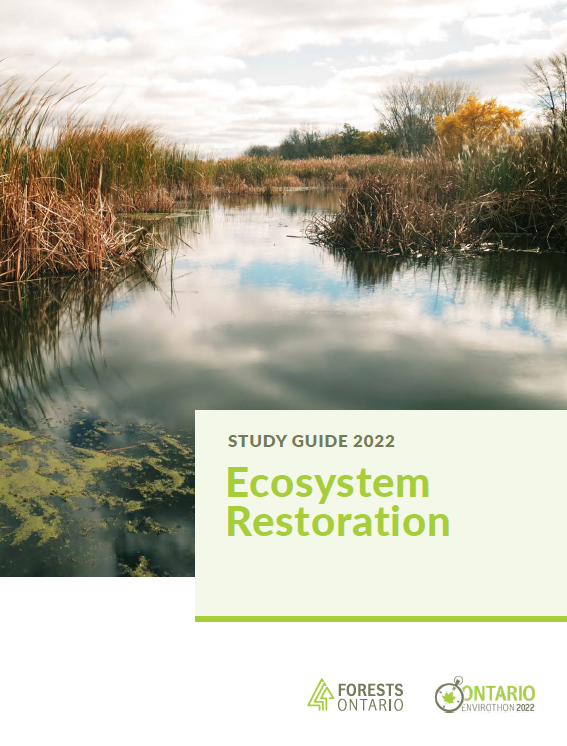Forest Ontario: Ecosystem Restoration Guide

Introduction
This resource was submitted by the Climate Risk Institute for theCanAdapt Climate Change Adaptation Community of Practice.
This article is an abridged version of the original text, which can be downloaded from the right-hand column. Please access the original text for more detail, research purposes, full references, or to quote text.
An ecosystem is a biological community of interacting organisms and their physical environment. Ecosystems have historically been degraded, damaged, or otherwise destroyed due to human disturbances that alter their structure or function. These damaged ecosystems that were once home to a host of plants and animals face increased stress from diminished, suboptimal habitats and have led many once-thriving species to be deemed at-risk.
Ecosystem restoration is the process of recreating, initiating, or accelerating the recovery of an ecosystem that has been disturbed, or otherwise changing the course of its recovery. This can include restoring the soils on a site, removing invasive or otherwise weedy vegetation and replacing it with more beneficial plants, and so on.
As there are a variety of ecosystems and disturbances found and occurring in Ontario, let alone Canada, there is no one-size-fits-all plan that works for all of them. Long-term studies and innovation are key steps in any restoration initiative and can be facilitated by various government and non-government organizations. Private landowners, both personal and corporate, can also be amazing and very necessary partners for restoration projects.
Ecosystem restoration occurs at the organism level but requires effort from municipal, provincial, and national governments. These efforts are at the forefront of the United Nations Decade on Ecosystem Restoration. This global effort began in 2021 and will run through to 2030 as a broad, global movement that aims to bring awareness and political momentum to ecosystem restoration, allowing restoration projects to gain the funding, partnerships, knowledge, and project resources to restore vital ecosystems.
In this study guide, students will be introduced to ecosystem restoration, the impacts made on different types of ecosystems, how different ecosystems can be restored, and who some of the key players are in restoring Ontario’s ecosystems. This guide explores terrestrial, aquatic, soil, and wildlife restoration and discusses restoration efforts, action plans and case studies, as well as the organizations that have brought these restoration efforts to life.
Learning Objectives
KEY IDEAS
1. Basic principles of ecosystem restoration.
2. How ecosystems function and the services they provide.
3. The issues that aquatic and terrestrial ecosystems face and how they can be addressed in restoration efforts.
4. The importance of soils and how they can be restored to sustain healthy ecosystems.
5. How conservation and restoration efforts impact wildlife.
6. The role of various levels of government, businesses, individuals, and Indigenous groups in restoring ecosystems.
LEARNING OBJECTIVES
1. Understand the basic principles of ecosystem restoration and apply them on local, provincial, national, and international scales.
2. Define and understand key terms including ecosystem afforestation, biodiversity, species at risk, invasive species, remediation, and degradation.
3. Analyze the issues facing a variety of ecosystems and identify steps that can be taken to restore the landscape.
4. Understand the planning and process behind ecosystem restoration projects.
5. Understand the purpose and goals of a Remedial Action Plan (RAP) and how a RAP can be used for aquatic ecosystems, in particular the Great Lakes.
6. Understand the role of soils and describe practices involved in the conservation and management of healthy soils.
7. Investigate methods for restoring ecosystems critical to the survival of species at risk.
8. Understand how invasive species impact ecosystems and identify specialized
techniques for invasive species management and removal.
9. Identify various levels of government, organizations, and Indigenous groups involved in ecosystem restoration and describe their respective roles.
About this Publication
The following study guide was created by a team of students from the Ecosystem Management Technology Program at Fleming College. The team comprised of Sydney Shepherd, Cheryl Abernethy, Morgan Lane, and Alexandra Paetzold. The purpose of the study guide is to provide high school students with study materials that reflect the 2022 Ontario Envirothon Current Issue Topic: Ecosystem Restoration. Key topics and learning objectives and interspersed throughout this document and are accompanied by various case studies and hands-on activities.
This study guide was produced for and edited by Forests Ontario with the support of Forest Ontario’s Education Outreach Coordinator Madeleine Bray, and Education Manager Allison Hands. Special thanks are also given to Sara Kelly, faculty member of the Ecosystem Management program at Fleming College.
Acknowledgements also given to those who reviewed the study guide: • Corey Ogden, The Regional Municipality of York • Donnell Gasbarrini, Toronto Zoo • Heather Cray, School for Resource and Environmental Studies, Dalhousie University • Robert Monico
Related reading:
Related weADAPT articles:
Related resources
- REDD+ 101
- Forests and trees for adaptation: the 6 main stories
- Sustainable Boreal Forest Management – Challenges and Opportunities for Climate Change Mitigation
- The Chiquitania fires: the role of water resources in forest restoration plans
- Virtual reality for education: an immersive trip into the Andean Tropical Mountain Forests
- Forests and Climate Change Toolbox
(0) Comments
There is no content